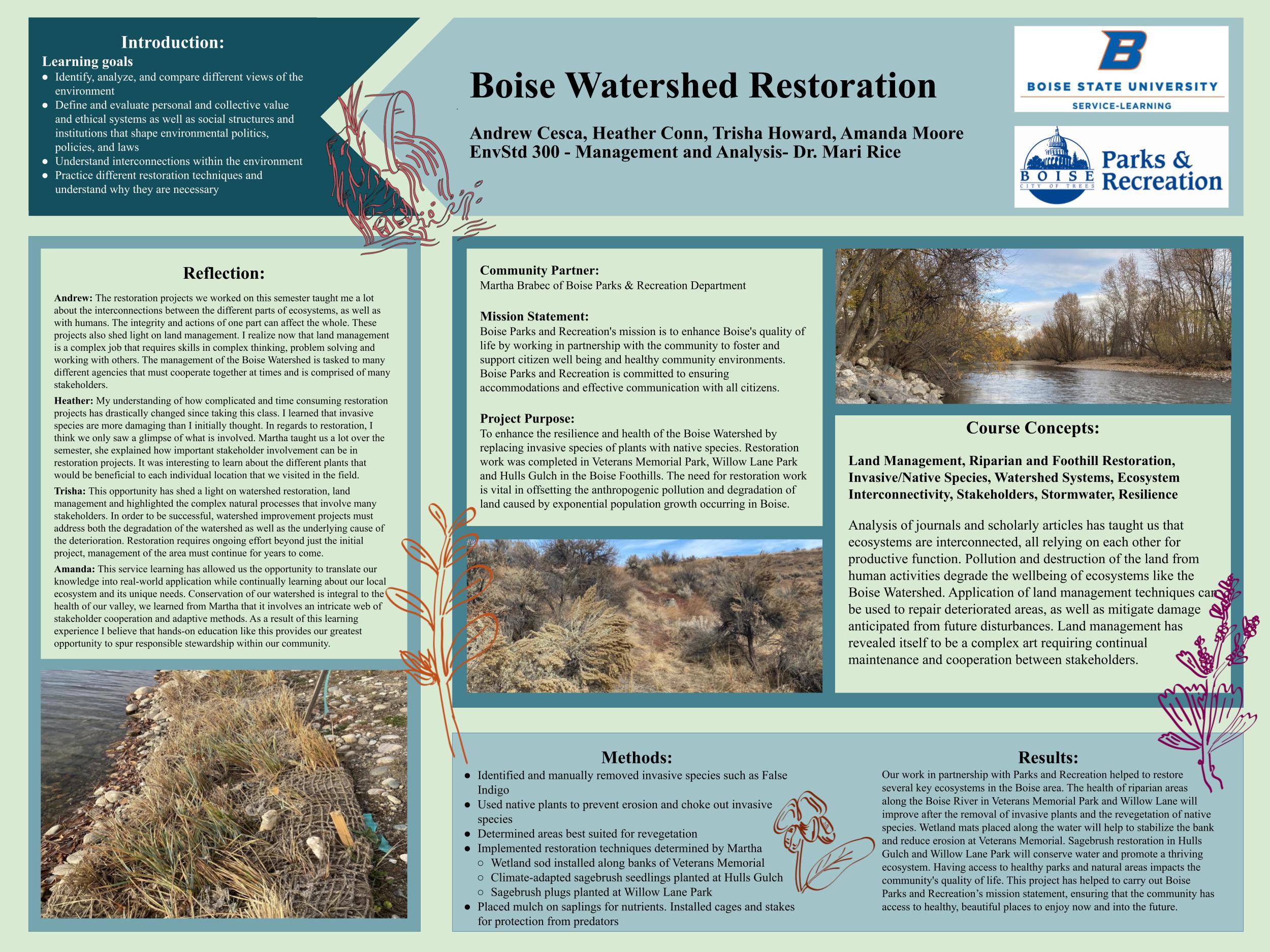Andrew Cesca, Heather Conn, Trisha Howard, Amanda Moore
Dr. Mari Rice – ENVSTD 300
Boise Parks and Recreation

Select to view full poster image.
Introduction
Learning Goals:
- Identify, analyze, and compare different views of the environment
- Define and evaluate personal and collective value and ethical systems as well as social structures and institutions that shape environmental politics, policies, and laws
- Understand interconnections within the environment
- Practice different restoration techniques and understand why they are necessary

Reflection
Andrew: The restoration projects we worked on this semester taught me a lot about the interconnections between the different parts of ecosystems, as well as with humans. The integrity and actions of one part can affect the whole. These projects also shed light on land management. I realize now that land management is a complex job that requires skills in complex thinking, problem solving and working with others. The management of the Boise Watershed is tasked to many different agencies that must cooperate together at times and is comprised of many stakeholders.
Heather: My understanding of how complicated and time consuming restoration projects has drastically changed since taking this class. I learned that invasive species are more damaging than I initially thought. In regards to restoration, I think we only saw a glimpse of what is involved. Martha taught us a lot over the semester, she explained how important stakeholder involvement can be in restoration projects. It was interesting to learn about the different plants that would be beneficial to each individual location that we visited in the field.
Trisha: This opportunity has shed a light on watershed restoration, land management and highlighted the complex natural processes that involve many stakeholders. In order to be successful, watershed improvement projects must address both the degradation of the watershed as well as the underlying cause of the deterioration. Restoration requires ongoing effort beyond just the initial project, management of the area must continue for years to come.
Amanda: This service learning has allowed us the opportunity to translate our knowledge into real-world application while continually learning about our local ecosystem and its unique needs. Conservation of our watershed is integral to the health of our valley, we learned from Martha that it involves an intricate web of stakeholder cooperation and adaptive methods. As a result of this learning experience I believe that hands-on education like this provides our greatest opportunity to spur responsible stewardship within our community.
Community Partner: Boise Parks and Recreation
Mission Statement:
Boise Parks and Recreation’s mission is to enhance Boise’s quality of life by working in partnership with the community to foster and support citizen well being and healthy community environments. Boise Parks and Recreation is committed to ensuring accommodations and effective communication with all citizens.
Project Purpose:
To enhance the resilience and health of the Boise Watershed by replacing invasive species of plants with native species. Restoration work was completed in Veterans Memorial Park, Willow Lane Park and Hulls Gulch in the Boise Foothills. The need for restoration work is vital in offsetting the anthropogenic pollution and degradation of land caused by exponential population growth occurring in Boise.

Course Concepts
Land Management, Riparian and Foothill Restoration, Invasive/Native Species, Watershed Systems, Ecosystem Interconnectivity, Stakeholders, Stormwater, Resilience
Analysis of journals and scholarly articles has taught us that ecosystems are interconnected, all relying on each other for productive function. Pollution and destruction of the land from human activities degrade the wellbeing of ecosystems like the Boise Watershed. Application of land management techniques can be used to repair deteriorated areas, as well as mitigate damage anticipated from future disturbances. Land management has revealed itself to be a complex art requiring continual maintenance and cooperation between stakeholders.
Methods
– Identified and manually removed invasive species such as False Indigo
– Used native plants to prevent erosion and choke out invasive species
– Determined areas best suited for revegetation
– Implemented restoration techniques determined by Martha
– Wetland sod installed along banks of Veterans Memorial
– Climate-adapted sagebrush seedlings planted at Hulls Gulch
– Sagebrush plugs planted at Willow Lane Park
– Placed mulch on saplings for nutrients. Installed cages and stakes for protection from predators

Results
Our work in partnership with Parks and Recreation helped to restore several key ecosystems in the Boise area. The health of riparian areas along the Boise River in Veterans Memorial Park and Willow Lane will improve after the removal of invasive plants and the revegetation of native species. Wetland mats placed along the water will help to stabilize the bank and reduce erosion at Veterans Memorial. Sagebrush restoration in Hulls Gulch and Willow Lane Park will conserve water and promote a thriving ecosystem. Having access to healthy parks and natural areas impacts the community’s quality of life. This project has helped to carry out Boise Parks and Recreation’s mission statement, ensuring that the community has access to healthy, beautiful places to enjoy now and into the future.